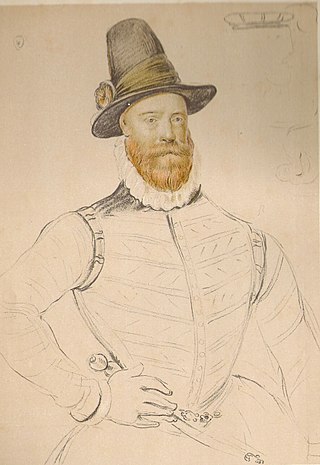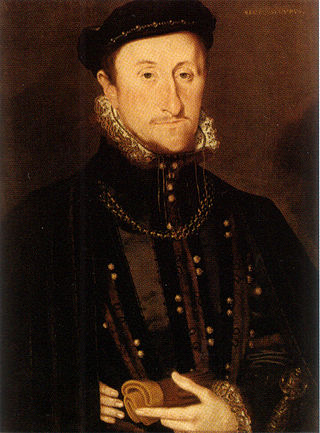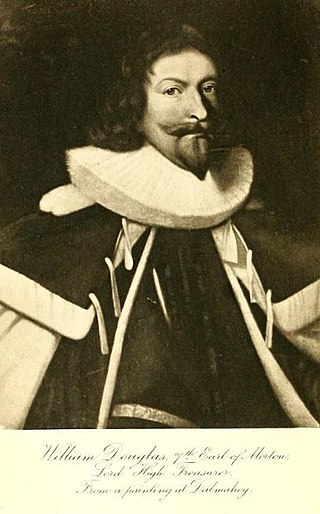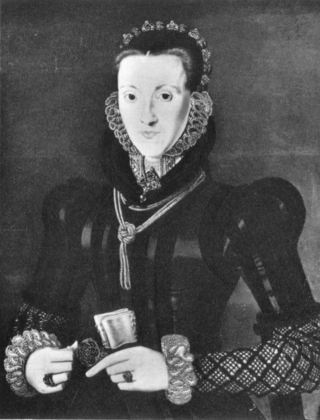Life
He was the eldest son of John Lyon, 7th Lord Glamis, by his wife, Janet Keith, daughter of Robert Keith, Master of Marischal, and sister of William Keith, 4th Earl Marischal. He succeeded as Lord Glamis on the death of his father in 1558. His name first appears in the list of members of the privy council at a meeting of 22 December 1561. On 10 September 1563 the island of Inchkeith was committed to his charge. [1]
Glamis supported the marriage of Mary Queen of Scots with Henry Darnley, and took part in the roundabout raid against James Stewart, 1st Earl of Moray. At the time of the murder of Darnley he was in Edinburgh, but may have had no knowledge of the conspiracy. He signed the Ainslie Tavern Bond for the marriage of James Hepburn, 4th Earl of Bothwell to the queen; but later joined the association for the overthrow of Bothwell and the protection of the young king James VI of Scotland. On 16 February 1569 he was appointed one of a committee for the pursuit of George Gordon, 5th Earl of Huntly. He was one of those who voted against the queen's divorce, 31 July 1569, and assisted with other seven noblemen in bearing the body of the Regent Moray at his funeral to St Giles' Cathedral, 14 February 1570. [1]
On 30 September 1570 Glamis was appointed an extraordinary lord of session. After Moray's death he became a close associate of his kinsman James Douglas, 4th Earl of Morton, whom in 1571 he accompanied on an embassy to England, in order to defeat proposals to restore Queen Mary to the throne. On 18 June 1572 he was ordered with other northern nobles to proceed against Adam Gordon of Auchindown, who had invaded The Mearns, and in July he barely escaped capture by Gordon at Brechin. On 2 September 1573 he and other barons of the north signed a band of allegiance to Morton, now Regent, and he was thought to be one of the most loyal of his supporters. [1] On the death of Archibald Campbell, 5th Earl of Argyll he was appointed to succeed him as Lord chancellor of Scotland on 8 October 1573. [2]
Like many Scottish aristocrats, Glamis was often short of money, and seems to have regularly borrowed from the Edinburgh lawyer John Shairp of Houston. [3]
When the question of episcopacy was occupying the attention of the lords of the congregation, Glamis corresponded with Theodore Beza on the subject in 1575, and Beza wrote the treatise De triplici Episcopatu, prompted by some of his queries. After the complaint of Colin Campbell, 6th Earl of Argyll to the young king of 4 March 1578, regarding Morton's overbearing demeanour, Glamis joined with other noblemen in advising Morton's resignation, and was one of a deputation sent to ask him to resign. In consenting, Morton is supposed to have taken influenced by Glamis's advice. [1]

James Douglas, 4th Earl of Morton was a Scottish nobleman. He played a leading role in the murders of Queen Mary's confidant, David Rizzio, and king Henry Darnley. He was one of the last of the four regents of Scotland during the minority of James VI and I. He was in some ways the most successful of the four, since he won the civil war that had been dragging on with the supporters of the exiled Mary, Queen of Scots. However, he came to an unfortunate end, executed by means of the Maiden, a predecessor of the guillotine.

James Stewart, 1st Earl of Moray was a member of the House of Stewart as the illegitimate son of King James V of Scotland. At times a supporter of his half-sister Mary, Queen of Scots, he was the regent of Scotland for his half-nephew, the infant King James VI, from 1567 until his assassination in 1570. He was the first head of government to be assassinated with a firearm.
John Stewart, 4th Earl of Atholl, called the Fair, was a Scottish nobleman and courtier. He was favoured by Mary, Queen of Scots, but later turned against her.

Mary of Scotland is a 1936 American historical drama film starring Katharine Hepburn as the 16th-century ruler Mary, Queen of Scots. Directed by John Ford, it is an adaptation of the 1933 Maxwell Anderson play, with Fredric March reprising the role of Bothwell, which he also performed on stage during the run of play. The screenplay was written by Dudley Nichols. Ginger Rogers wanted to play this role and made a screen test, but RKO rejected her request to be cast in the part feeling that the role was not suitable to her image.
Archibald Douglas, 8th Earl of Angus and 5th Earl of Morton was a Scottish aristocrat.
William Douglas, 6th Earl of Morton was the son of Robert Douglas of Lochleven and Margaret Erskine, a former mistress of James V of Scotland.

William Douglas, 7th Earl of Morton was a grandson of the 6th Earl of Morton. He was Treasurer of Scotland, and a zealous Royalist.
George Gordon, 5th Earl of Huntly, was Lord Chancellor of Scotland and major conspirator of his time.

Agnes Keith, Countess of Moray was a Scottish noblewoman. She was the wife of James Stewart, 1st Earl of Moray, regent of Scotland and the illegitimate half-brother of Mary, Queen of Scots, making her a sister-in-law of the Scottish queen. As the wife of the regent, Agnes was the most powerful woman in Scotland from 1567 until her husband's assassination in 1570.

Agnes Leslie, Countess of Morton was a Scottish noblewoman, being the daughter of George Leslie, 4th Earl of Rothes as well as a great-granddaughter of King James II. She was the wife of William Douglas, 6th Earl of Morton, who as Laird of Lochleven Castle was the custodian of Mary, Queen of Scots during her captivity from June 1567 until her escape on 2 May 1568. Agnes was Queen Mary's chief female companion throughout her imprisonment; thus it was while Lady Agnes was recovering from childbirth that the queen successfully escaped from Lochleven.

The Ainslie Tavern Bond was a document signed on about 20 April 1567 by a number of Scottish bishops and nobles. The bond approved the Earl of Bothwell's acquittal on 12 April of implication in the murder of Lord Darnley, recommended him as an appropriate husband for Mary, Queen of Scots, and pledged to assist in defending such a marriage.

William Keith, 4th Earl Marischal was a Scottish nobleman and politician.
Sir Thomas Lyon, Master of Glamis was a Scottish nobleman and official, Lord High Treasurer of Scotland.
Patrick Lindsay, 6th Lord Lindsay of the Byres, (1521–1589), Scottish courtier and Confederate lord.
Laurence Oliphant, 4th Lord Oliphant (1529–1593) was a Scottish nobleman.
The Decreet of Ranking of 5 March 1606 determined the relative precedence of members of the peerage of Scotland.

Patrick Lyon, 1st Earl of Kinghorne was a Scottish landowner.
Alexander Abernethy, 6th Lord Saltoun was a Scottish landowner and courtier.
Jean Lyon, Countess of Angus was a Scottish courtier and landowner, who became involved in a witchcraft trial.
Sir John Wishart of Pitarrow was a Scottish lawyer, courtier, comptroller of the exchequer, and rebel.
![]() This article incorporates text from a publication now in the public domain : Lee, Sidney, ed. (1893). "Lyon, John (d.1578)". Dictionary of National Biography . Vol. 34. London: Smith, Elder & Co.
This article incorporates text from a publication now in the public domain : Lee, Sidney, ed. (1893). "Lyon, John (d.1578)". Dictionary of National Biography . Vol. 34. London: Smith, Elder & Co.







